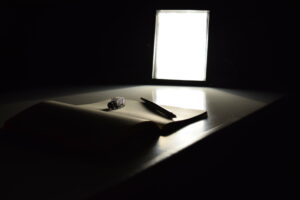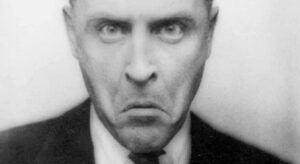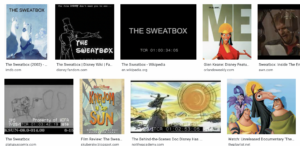Lamentations
Please welcome guest author Emilie-Noelle Provost to Writer Unboxed today! Emilie-Noelle is an accomplished editor and writer, having held editorial positions with four magazines and written hundreds of articles over the years. She has a published book of middle-grade fiction, The Blue Bottle, and her first novel of adult fiction, The River is Everywhere–about a 16-year-old who must overcome doubt after his best friend’s shattering death–will release on March 14th.
“Provost’s writing is vivid, and her pace is swift. Readers of all ages will be drawn to this moving coming-of-age tale.”
– Paul Marion, editor of Atop an Underwood, the early work of Jack Kerouac
“Ernest Benoit’s odyssey begins as a search for some meaning that can help him better understand his best friend’s tragic death. But his, at times, dangerous journey quickly becomes a search for his own roots and soul. Provost is a gifted storyteller. The River Is Everywhere is well worth your time.”
– Stephen P. O’Connor, author of The Witch at Rivermouth
Though The River is Everywhere has not yet released, Emilie-Noelle has unfortunately already experienced online harassment over it. Today, she shares that encounter and some advice on how to cope with it.
You can follow Emilie-Noelle on Twitter and Facebook, and learn more about The River is Everywhere on her website: emilienoelleprovost.com. Welcome, Emilie-Noelle!
The day I signed the publishing contract for my second novel, I wrote a post about it on LinkedIn. I tagged the book’s soon-to-be publisher in the text, and included an image of their logo. The small press publishes just ten books a year. The fact that my book would be one of them was tremendously validating. I was delighted to share my good news.
Within minutes of the post going live I received a comment from a writer I was connected with on the platform but didn’t know very well. “That’s a vanity press!” he wrote. “Don’t publish your book with them. You’ll ruin your credibility. Everything you’ve worked for will go down the drain!”
Thinking this person was simply misinformed, I replied. “You must be confusing them with another publisher,” I wrote. “These guys are the real deal.” As proof, I added the link to my new publisher’s website. Believing I had settled the matter, I logged off.
When I looked at the post again later, I was horrified to discover that the same person had gone on an all-out digital tirade, posting multiple comments about how the publisher I had signed with wasn’t legitimate, and that as an author, neither was I. I realized then that, for some reason I still don’t understand, this complete stranger was trying to publicly discredit me and my work. I reported his comments to the site’s admin, removed him from my connections, and deleted the post.
The feeling of accomplishment I’d had that morning evaporated. I was sad and confused. I’d worked on that book for years. Why would a person who knew nothing about me or my work put so much effort into casting doubt on my achievement? Why would anyone be so mean to someone they don’t even know?
Some people get their sustenance from tearing apart others’ creative work. […]
Read MorePlease welcome guest author Henriette Lazaridis to Writer Unboxed today! Henriette’s new novel, TERRA NOVA, will be published by Pegasus Books in December 2022. Her debut novel, The Clover House, was a Boston Globe bestseller and a Target Emerging Authors pick. Her work has been published in such outlets as Elle, Forge, Narrative Magazine, The New York Times, New England Review, The Millions, WBUR’s Cognoscenti and Pangyrus, and she is a recipient of a Massachusetts Cultural Council Artists Grant. Henriette earned degrees in English literature from Middlebury College, Oxford University, where she was a Rhodes Scholar, and the University of Pennsylvania. Having taught English at Harvard, she now teaches at GrubStreet in Boston. Visit her website at https://www.henriettelazaridis.com/.
Linger, Tinker, Savor: Taking the Time to Get it Right
I came to novel-writing later in life, after a career in academia. Though I’d decided as a teenager that I wanted more than anything to be a novelist, one thing led to another, and I detoured into scholarship and teaching at the university level, and then I was almost forty when I realized I’d strayed from my once-held dream. Starting “late”—or so I thought—I became a Woman in a Hurry. It’s not that I wrote massive amounts right away. Quite the contrary, in fact. I didn’t take myself seriously for a few years and kept undermining myself by engaging in all manner of other pursuits on top of (and often in place of) writing. But even then, I was in a hurry mentally. When I did finally get serious about writing novels, I wanted everything to happen fast.
My first novel, The Clover House, set me up for some false expectations of speed to come. The novel went on sub on a Thursday and, by the Monday, I had phone interviews with three publishers. About three weeks later, I had a sale. This gave me the impression it would always go like this. You write the draft, you revise a little, you go on sub, and bingo, you sell. I imagined doing this on a sort of two-year timetable and queued up my ideas accordingly.
Insert a pause for sad-maniacal laughter.
No, the next manuscript I wrote did not go off into publication at lightning speed. Nor did the next one. But though the publishing world’s operations were slowing me down, I continued to write if not quickly then briskly. I began a third manuscript, and then set it aside to revise one of the two novels I’d already completed, reworking it under the skillful and attentive scrutiny of my then agent. Before the ink was barely dry on a finished draft of Terra Nova, I began and finished another manuscript, during the pandemic (didn’t everyone?), in a matter of months.
The take-away from all these manuscripts bouncing around in my writerly existence isn’t the speed of their creation. That’s, in fact, the cautionary tale. The real lesson is that the ones that really succeeded were the product of time and slowness. Notice that while we have a nifty word for when things are fast—speed!—the word for when things are slow is awkward. Slowness? And yet, there it is: a word that takes as much drawn-out time to say as is fitting for its meaning. What worked best for me as a […]
Read MoreSpooky season is here — and what could be more horrifying or haunting to a writer than the projects that have met tragic ends?
Whether big or small, we all have a graveyard of failed work. The novels we got 10K words into, and then just lost steam on. The essay that never quite came together. The manuscript that garnered a decent number of requests from agents, yet couldn’t land an offer. The seeds of ideas that simply never managed to grow into anything more.
Some of these deaths hurt more than others. My personal cemetery includes all of them and more.
Because I am a slow writer, the most common cause of death for my writing projects is running out of momentum, interest, or relevance. Similar to tombstones marked with the years of birth and death, my hard drive is littered with files labeled “Road Trip Novel (2016 version),” then “Road Trip Novel (2018 version),” then “Road Trip Novel (2021 version),” and such, until finally I realize it is futile. No matter how many times I try to revive it, the window for this story has already closed. Maybe the headline that inspired it has become old news. Or the internal struggle I was having, and that I built a whole story around, has resolved itself. (More likely, it has been replaced by some new and more pressing anxiety, haha.) Whatever the reason, the fuel for this work has been exhausted, and my energy would be better spent moving on to the next thing. To be fair, this seems like a relatively natural and peaceful way for a story to die.
On the other hand, I’ve had to “murder” a project once or twice, after realizing that I simply wasn’t the best writer to tell it. (Jeanne Kisacky recently opened a good discussion about this right here at Writer Unboxed: “Who Are You Reading Now?”) For example, many years ago, I started a story about a bisexual Black teenager who was being bullied by a former best friend, so her mother sent her to live temporarily with a friend in Barcelona. Certain elements were drawn from my own experiences, and the heart of the story — about a girl who heals herself with the help of found family in a foreign place — still calls to me. But other aspects felt like too much of a stretch for me to write well, and were simply too important to risk getting wrong. For a while, I resisted what had to be done, but eventually I came to see it as a mercy killing, on several levels.
By far the most painful addition to my graveyard came from the manuscript that snagged me two offers of representation from top-notch agents, only to die a drawn-out, back-and-forth death on submission. I spent 3 years writing and revising that book, 3 months querying, 6 months on submission, and finally, at least 9 months in mourning for the future that it (and I) would not get to have. Does it haunt me? Absolutely. In the time since then, I have racked my brain with doubts and second guessing. Was it bad luck, bad timing, bad writing? Should I have just […]
Read MoreAs I sit at my desk, my wireless keyboard waiting expectantly, my fingers hover ever so lightly on its keys. My extra wide gaming screen shines brightly in my eyes, with the minutes ticking away as the TV in the background emits white noise. I wait for the words to come. And wait. And wait.
They don’t come.
I swivel in my chair facing the TV, thinking, “Oh, General Hospital’s on,” and realize that it’s 2 pm and the day has slid past me. I have to pick up my kid in an hour, talk about the school day, and maybe make dinner. Hopefully, I’ll be able to write before I get sleepy.
I should have started writing at 8 am, typing my way to literary heaven. I should have banged out at least 1600 words to keep up with my Scrivener target count and deadline.
I didn’t.
Instead, I whiled the day away, sitting at this desk. I daydreamed. I lamented. I checked social. I texted. I even paid some bills — and who the hell wants to do that? I begged for words to drop into my head so I could write They Come At Knight. It didn’t happen the next day, or the next, or the next…for months.
The words abandoned me. Creativity that once flowed, betrayed me, leaving me insecure and confused. Second-guessing myself and angry that words seemed so effortless for everyone, I struggled to get down ten. I developed a debilitating fear that I was going to disappoint everyone: my publisher, my agent, my family and friends, the readers.
I don’t include myself in that list of people who I was going to disappoint because writing, to me, was no longer for me. It was for everyone else. That’s why I became too paralyzed to write.
When I wrote Her Name Is Knight, I wrote for me. I wrote to get out this story that had been building within me for years. I wrote while holding down a demanding full-time job and commuting daily, raising kids, and other family duties. When the house was finally quiet because my kids are great like that, I sat on my bed and wrote the night away. Effortlessly. Because I was writing for me. With no expectations. No limitations. No deadline looming over my head. No promoting one book while attempting to write the other. No one was waiting for my first book but me. And that feeling was glorious!
I had to write the second book before the first one was even released. I didn’t know how HNIK would be received. How could I write a sequel when I didn’t know what worked, or not, with the first? I guessed. I wrote the story and prayed everyone would love it too. I know how people can be when the sequel isn’t like the first. I didn’t want to disappoint before I even knew what would be disappointing.
Then the reviews started rolling in. Everyone seemed to love Nena Knight and her story. They said such marvelous things, calling the voice haunting, telling me they cried when they read the end. Good, because so did I! I received emails where readers told me just how much my book meant to them. Stuff I would say […]
Read MoreNote: This post does not contain a happy ending.
In Seattle, June is the cruelest month. Terrifying. Violent, too. A month where people rarely leave their homes, and if they must, they hurry from house to car, exhaling only once safely inside, windows rolled up, doors locked. In June, schools forgive truancy. Non-urgent appointments–dental check-ups, meetings with financial planners, eyebrow shaping–pretty much anything other than trips to the ER–are put off until mid-July.
Have you seen Hitchcock’s film, The Birds? Hitchcock himself claimed, “It could be the most terrifying motion picture I have ever made.”
I bet Hitchcock was inspired by Seattle in June.
Because of Poe’s quothing ravens, I’ve always found crows a bit sinister, but in general, I had no beef with any corvids, not really, until June 2013. While walking to get my daughter at school, a crow–out of nowhere–slapped me across the back of the head with a rolled-up magazine. At least, that’s what it felt like.
The June 2015 NPR story, “They Will Strafe You,” taught me these attacks are common. I was simply in the wrong place (near the crow’s fledglings) at the wrong time (June, fledgling season). This particular crow, undoubtedly sleep deprived and struggling with postpartum depression, deemed me a threat. Thus, she grabbed her June 2013 issue of The New Yorker, or perhaps The Economist, or maybe it was The New Republic, and whacked my head.
I began to fear another strafing.
“No eye contact, people!” I’d yell at my children, my husband, my dog, whenever I saw a crow. “You make eye contact, and THEY WILL STRAFE YOU!”
The whole world was starting to feel unsafe, and not just in June. Year-round, I felt the beady eyes of crows upon me.
Fast forward nine (terror-filled) years, and we arrive at Spring 2022.
At the end of May, bunion surgery left me horizontal with my sad, swollen foot in the air. For weeks, I crutched only between the TV room sofa and my Room of Convalescence. Back and forth, forth and back.
Bedridden and homebound, I could not escape their terrible cawing, could not ignore the murderous shadows that darkened my windows. Twenty-three days post-op, loopy with a weird mix of boredom and fatigue, tired of my POW status, I raised my fist at the crow-laden spruce in my yard.
“Nevermore!” I shouted. “NEVERMORE!”
After Googling “what do crows eat,” (the answer: “pretty much anything”) I crutched to the kitchen and found a box of stale, generic-brand Wheat Thins. […]
Read MoreWe’re thrilled to have returning guest Danielle Davis on Writer Unboxed today! Danielle has had dark fantasy and horror published in Andromeda Spaceways Magazine, The Astounding Outpost, and multiple anthologies. You can find her on most social media under the handle “LiteraryEllyMay” and at her website, literaryellymay.com
It’s Not Me, It’s the Story
Have you ever reached a point where you couldn’t see the path forward while writing your story, and found yourself saying, “What is wrong with me?” It’s an easy trap to fall into, to see our stories as a projection of ourselves and to equate our story’s perceived value with an internal sense of worth. We put so much of ourselves into our writing that it’s a natural tendency to create an inflated sense of connection between the two and to take it personally when the story doesn’t want to work the way we want it to. This, in turn, drains motivation and makes it hard to move past those negative feelings.
In her TED Talk, “Teach Girls Bravery, Not Perfection,” Reshma Saujani provides the anecdote of a friend who is an instructor at the University of Columbia. During office hours with his computer science students, he noted that men struggling with an assignment would say, “Professor, there’s something wrong with my code.” But when the women came in, they said, “Professor, there’s something wrong with me.”
This resonated with me. I, too, struggle with the culture that Saujani coins “perfection or bust” when I’m working on a story. I often beat myself up about not being further along as an author or tell myself that it’s a personal failing on my part. I tell myself that mine are pipe dreams and I’m just not cut out for this work. It’s a pervasive thought, that you aren’t enough, and if you’re not careful, it can fester and grow into a writer’s block that sticks.
Not too long ago, after wrestling with a sudden dead-end in my WIP, I went to my husband and lamented, “It’s not working out. I think I’m just not the writer for this story.” He very quickly (and correctly) called me out about it. Talking with him made me realize that it wasn’t ME. I wasn’t the failure. Elements in my story needed to be improved. A few tears and several days later, I realized what wasn’t working and made the necessary corrections. And it began to move again.
In the process, I began to identify several ways to fight that sense of personal failure and inadequacy:
Read More
Please welcome author and community member Tom Pope back to WU today! Tom was a singer/songerwriter in Hollywood for twenty years before turning to novels. His second novel The Trouble with Wisdom is a cross-genre tale, being compared to a union of McCarthy’s The Road and Mattiessen’s The Snow Leopard, a dystopian story that gives rise to hope. It launches this Tuesday, 2/22/22. A prolific guy, Tom has four more novels in the pipe line.
We’re thrilled that he’s here today to bring us a provocation about hope, fear, and creation.
Learn more about Tom and his novels on his website, and by following him on Facebook and Twitter.
Joan Didion’s passing reminded me that after no one pronounced my first book brilliant, trendsetting, and sure to meet with fabled destiny, I realized I was slouching toward Neverland and quit writing for good.
It may surprise you that the next books I wrote in spite of my commitment to join the circus to avoid writing also sucked. My secret is: angst and self-contempt make for wonderful inspiration to get to the writing nook, so in my spare time I hone them to a sharp edge. In addition, ruinous doubt has proved to be a powerful enhancement for doing my best work. . .
. . . Said no author ever.
The Place of Dopamine
According to endocrinology and other scientific disciplines I can’t pronounce, success—such as landing a publishing deal—triggers dopamine response, which fuels happiness. But before you run too far with that, consider that eating food, sleeping well, and taking a bath produce the same result.
In the interest of personal and community care, as authors, let’s lay the cards on the table. 1) Writing involves nearly endless intricacies of the highest form of human cognition along with the mastery of many particular skills. Only the initial aspects of these capacities can be taught. Sharpening them is up to us. 2) The fabrication is time consuming. 3) Underlying each stage of writing lies a barely understood ability of mind—the creative process. Let’s take a moment to acknowledge the challenging landscape we work in.
The publishing industry, on the other hand, is not particularly interested in these things, including our dopamine response. So why would we—except under threat of death—surrender our symbiotic relationship with it in favor of taking a fused subordinate position if doing so weakens our passion to write, the quality of the work, and most importantly our ability to live happy and fulfilling lives . . . which can enhance our writing?
Earth, Sky, and Sales
Regarding creativity, consider each of us is bound by the parameters of the soil from which our creative process springs; things like our culture, country and history, our education and dwelling situation, and our health, backstory and gender. These conditions shape the stories which arise in the blue sky of our creativity. We cannot create what we cannot conceive.
What universal law, though, says that what we conceive will lie neatly on today’s idiosyncratic commercial path to fame and wealth? AND what axiom states that if our work doesn’t lie neatly there, it is bad? (That some authors solve this problem […]
Read MoreThe writing shed of my dreams, not my actual office
I saw a photo of Alix E. Harrow on twitter recently. In it, she’s wearing a baby in a front pack and has a toddler tucked under one armpit, her eyes are glazed — probably from sleep deprivation — and she’s typing madly away. In the caption, she reveals that the manuscript she’s working on will eventually become THE ONCE AND FUTURE WITCHES.
The photo made me nostalgic — I wrote my first book in much the same manner — and it also made me laugh, because–although I cannot fit my almost-adult children on my lap or under my arm anymore, nor would they be caught dead in either position–the search for a private place to write twenty years later is still ongoing.
I had an office in my first house — a loft with a tiny balcony overlooking our yard. The view was so lovely I set my desk against the wall so I wouldn’t be distracted, and I motivated myself with timed breaks on the balcony. The house had an open floor plan, which was perfect for two adults. But babies are much more distracting than views and after our first arrived, my productivity took a dive. Thankfully, we moved to another house soon after. This one had no balcony but did have the benefit of an office for me on the second floor, complete with a door that closed.
The room was large enough to hold a small couch, and often when I was working at night the door would creak open and my toddler would tiptoe in, board book and sippy cup in hand, secure in the knowledge that so long as she was quiet I wouldn’t rat her out to her dad, who had bedtime duty. I stocked the bookshelves, not just with craft tomes, but also with stuffed animals and quiet toys, and I painted the walls kid-friendly pastels. I wrote for newspapers and magazines in that room, and finished and sold my first novel from there.
But as time passed, the kids grew up and went to school. I no longer needed to barricade myself in to finish an article or chapter, no longer had to work only during nights and nap times. Oddly, now that I had what I’d longed for — a few uninterrupted hours of writing time — the office felt far too quiet. I took to wandering the house with my laptop, writing some days at the kitchen table, other times on the living room couch. When I truly felt like I was going crazy in the silence, I packed up and headed to a local library or coffee shop.
And then Covid struck. Like most everyone else, all my chickies came home to roost at once, filling the house. The two teenagers stayed mostly in their bedrooms, which left my husband. Who needed a place to work with a door that closed. A place like … my office.
On paper it made sense. He has a job that often involves discussing confidential information, whereas most of my conversations take place with people I’ve made up in my head. Even so, he was reluctant to […]
Read MoreI often turn to Disney and Pixar for easily identifiable examples of craft elements for my classes, as well as their approaches to plot in general. Their writing is dependably clean, clear, and effective in their most popular movies.
So when I heard there was a documentary Disney had banned about an unfinished movie, I was immediately intrigued. It appeared the documentary filmmakers had been granted unparalleled access behind Disney’s closed doors, gleaning a rumored 150 hours of footage. When the documentary debuted, Disney responded by buying up the rights and shoving the film into their infamous vault.
But the internet being what it is, a fine cut of the documentary exists in fairly frequent rounds. Its contents, however, are less about dirty Disney secrets and more about a universal truth that resonated a little too hard for me as a writer.
The documentary, called The Sweatbox, was directed by Trudie Styler (musician Sting’s wife) and John Paul Davidson, and premiered at festivals in 2002. Named after what the original Walt Disney crew called their screening room—at the time, a wooden shack with no air conditioning—this documentary depicted the wild ride that was the production of The Kingdom of the Sun, which would eventually turn into The Emperor’s New Groove. Why Disney apparently banned the documentary from further distribution, however, was less due to it being about an unfinished movie and more about the grueling process of writing itself–particularly, how often the final project becomes something nearly unrecognizable from its bright-eyed beginnings. The sweatbox, in so many words, is the unhappiest place on earth.
Released in 2000 and loosely set in ancient Peru, The Emperor’s New Groove is the story of Emperor Kuzco, a spoiled young man and unintentional queer icon who decides to build a Kuzco-only water park on the generations-old land of Pacha, a gentle llama herder. When Kuzco simultaneously fires his queer-goals royal adviser, Yzma, she decides to exact revenge by poisoning him and taking over. The plan is predictably botched when put into the hands of her himbo henchman, Kronk, and Kuzco is turned into a llama. Making a false deal with Pacha to spare his land, Kuzco and Pacha must return to the palace to change Kuzco back to human while avoiding Yzma and Kronk, who have since realized their blunder and are hunting Kuzco down.
The film is as silly as you can imagine such a plot to be, bordering on a near Looney Tunes quality of wacky mayhem. So far off the beaten path as it is, the film is frequently forgotten as a movie within the Disney canon. So how did it become what it became?
In late 1994/early 1995, Roger Allers, fresh off his successful co-direction of The Lion King, decided he wanted to make a film set in Peru.[1] After two years of research, planning, and production work with his team, he approached Sting in 1997 to write the music for The Kingdom of the Sun, at which point Sting had put the documentary into his Disney contract as a stipulation. Mark Dindal was also brought on as co-director of the feature film. The entire team then went full tilt into the work.
(A sidenote on representation: This is a movie inspired by Peru and […]
Read More





















